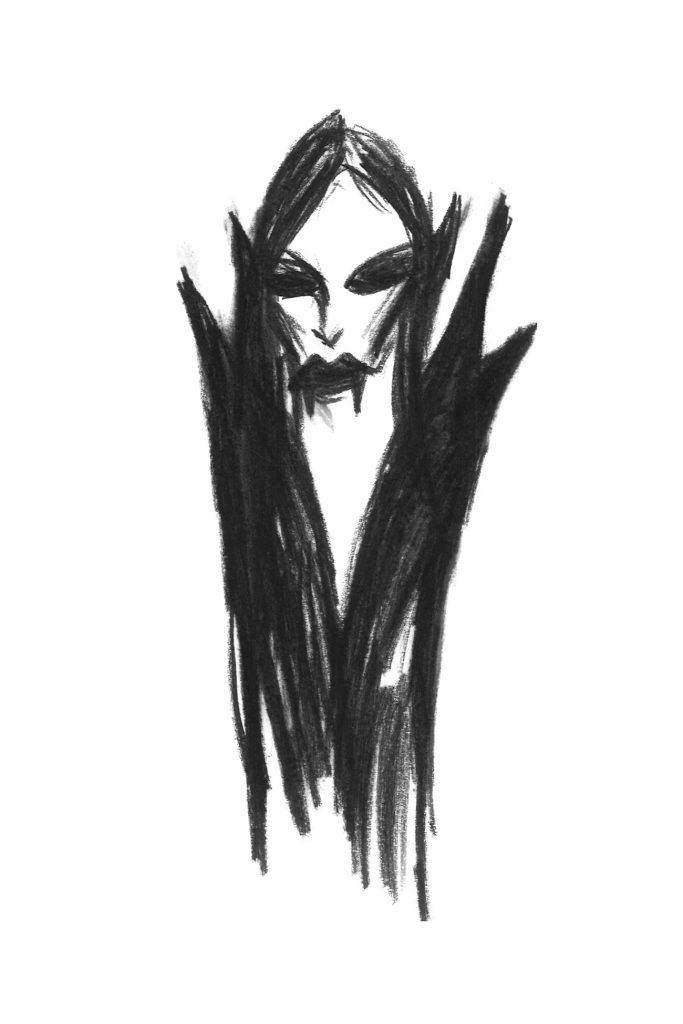Samuel Staples curated selection of vampire films
When I was five or six, I used to wear a bloodied vampire mask everywhere I went, no matter the day or time of year. My mom bought it as a Valentine’s day gift, to the cashier’s horror, probably on clearance from the Halloween before. I can’t remember a single Halloween that followed where I dressed up as anything else.
What makes vampires such enduring sources of obsession is their versatility. Both monstrous and seductive, the vampire is the ultimate abjection. A dark repository representing our collective desires as much as our fears, vampirism can be understood as an effective symbol for: illness, addiction, fame, relationships, capitalism, and our pursuit for eternal youth and beauty. To be a vampire, ultimately, is to exist on the outside of society and any established order or system, at least of the human world.

Blood for Dracula (1974), Paul Morrissey
Sex-soaked, filthy and deliberately camp, Paul Morrissey’s Blood for Dracula follows an ill and dying Count Dracula (played by Udo Kier) who travels to a religious pre-fascist Italy in search of virgin blood after running through all the virgins in Transylvania. In Italy, hoping to find some virgins, Dracula is welcomed by an aristocrat with an estate in decay looking to marry off his daughters, but instead encounters incestuous lesbians and a Marxist played by Warhol superstar Joe Dallesandro.
The Hunger (1983), Tony Scott
Dripping in 80s Gothic and dark-wave subculture, The Hunger is remembered arguably more for its visuals and intoxicating style (with costumes by Yves Saint Laurent) than anything else, but it’s kind of worth watching for the opening credits alone: A caged Peter Murphy bathed in cold blue light and animalistic intensity performing the iconic Bauhaus track Bela Lugosi’s Dead, as vampires John (David Bowie) and Miriam (Catherine Deneuve) hone in on their young prey. The film has endlessly inspired young goths since its release – among them Fred Berger, who went on to publish the cult 80s/90s zine Propaganda following its release.
In The Hunger, vampires suffer from accelerated organic decay, leading to their ultimate demise – still alive but barely living, the disease of immortality. The film follows John’s rapid decline as he ages decades in a few hours. “I’m a young man. Do you understand?” he confusedly pleads in one scene, to Dr. Roberts (Susan Sarandon), a geriatrician. The film is often retroactively discussed in the context of the AIDS crisis. Released in 1983, connections can easily be made to the confusion and shock in the early years of the crisis, in relation to the then-mysterious and deadly illness.
Trouble Everyday (2001), Claire Denis
Corporeal aesthetics, violence and sexual climax. Not so much your classic vampire film as it is a reflection on desire and disease; a poetic take by French filmmaker Claire Denis on the body-horror genre. The warped lovestory is an often-challenging exploration of the human condition and the consequences of surrendering to one’s own desire and carnal urges. Newlyweds Shane (a perfectly cast Vincent Gallo) and his wife June (Tricia Vessey) arrive in Paris for their honeymoon, where in the process of trying to find a cure for his restrained bloodlust he encounters a beautiful Béatrice Dalle, whose shared affliction leads her to lure truckers into remote fields with the promise of sex, which she happily fulfils before ripping them apart and revelling in their blood.
The Addiction (1995), Abel Ferrara
In the 1992 film Bad Lieutenant, directed by Abel Ferrara, there’s a scene where a junkie (played by writer Zoë Lund) provides a monologue about vampires. “Vampires have it easy. They feed on others. We have to feed on ourselves. We have to eat our legs, To have the energy to walk. We have to come, in order to go. We have to suck ourselves off. We have to eat away at ourselves ‘Til there’s nothing left But appetite.” Lund’s monologue underscores the conflicting nature of the characters within the film, and of addiction itself. According to Lund, who made no secret of her own heroin use, the speech was written minutes before it was shot, and done in one single take.
Ferrara would later direct an actual vampire movie, The Addiction, in 1995, which on its surface appears to be a metaphor for drug addiction but slowly reveals something much deeper. Staged in an already vampiric academic environment, the film follows NYU philosophy grad student Kathleen Conk as she grapples with her newfound bloodthirst, unravelling into a reflection about guilt, justice and the philosophical nature of evil itself.
Nosferatu. Eine Symphonie des Grauens (Nosferatu. A Symphony of Horror) (1922), F.W.Murnau
One of the most influential films produced in Weimar cinema, Nosferatu arguably established the vampire genre itself but also the vampire as a figure giving form to our subconscious fears and desires; a metaphor for disease, death, madness and obsession. Though the vampire played by Max Schreck only appears onscreen for a total of nine minutes, the tension created by the mere suggestion of his presence is visceral throughout. The film is a mainstay at Babylon theatre in Berlin regardless of the season, often accompanied by an actual symphony of horror/orchestra.
Nosferatu the Vampyre (1979), Werner Herzog
A tale of loneliness more than anything, and one of the rare instances where a remake or adaptation could possibly be better than the original? While Herzog’s version retains the basic storyline and characters from Murnau’s film and Stoker’s novel, the film deviates from the original in often beautiful ways. Werner Herzog’s films are marked by their cinematography capturing both the beauty and the brutality and essence of isolation of the natural world. There is a muddied quality to the photography in Herzog’s adaptation of Nosferatu; his world appears heavy, cold, dirty, even drowned at times. Klaus Kinski’s empathetic portrayal of the vampire is subtle and melancholic, highlighting the isolation and (eternal) loneliness of immortality.
